Scientists say the aurora borealis emits no sound. They're probably correct, but just try to convince this half-hobbled hiker, 50 miles and 16 hours into nonstop 100-mile trek through Alaska's White Mountains. For most of those hours, icy north winds pummeled my body until I wasn't sure whether my upper legs were numb from fatigue or cold. The hour was closing in on midnight, perhaps past; time had become fluid, swirling around my feet with the wind-driven snow. I was hobbled only because my legs hurt, with throbbing soreness that had gripped my quads since well before mile zero. But this wasn't bad, really. At least it wasn't getting worse.

I crested Cache Mountain Divide and continued shuffle-walking across the narrow saddle, dragging my feet to feel out the hidden trail base beneath a flowing stream of spindrift. I briefly switched on my headlamp and decided it was a detriment to visibility, as its white LCD glow washed out the shadows cast by the half moon. In moonlight, bald mountains glistened with a silver tint, and shadows etched the snow-covered landscape with stark definition. If I was a poet, I would write something about windows into the ancient soul of the mountain, moments of unobstructed clarity when the far reaches of time and space become briefly, strikingly visible.
More futile than attempting to describe such perspective is attempting to photograph it, but I pulled my little camera from an inside pocket, set the exposure to four seconds, and anchored it atop my trekking pole pogies. As I waited for the self timer, I perceived a low-pitched sound from the north — a rich, vibrating harmony best likened to Tuvan throat singers, or the quiet roar of a distant whitewater river. It was probably the wind, or imagination, but I
heard something, and this prompted me to wheel around and face the northern horizon.

What I saw was an auroral storm more intense than any I'd witnessed in five years of living in Alaska, and miles of winter endurance races that now number in the thousands. Photon waves rippled over the mountains until the entire sky was a river of green light — almost blindingly bright in the deeper channels, rolling into eddies of red-tinted and white streaks, then shimmering and disappearing into curled tails. The light moved so quickly that if I blinked it changed entirely. I was gobsmacked, simultaneously plopping down on my butt and wheezily screaming a string of obscenities that was entirely inappropriate. Alas, I am but an inarticulate human, with limited means to express what I feel in such moments.
I didn't even try to take another photo just then, as expressions of my feeble humanity were rightly silenced beneath the thundering universe. Time drifted past. I'm not sure how long I sat in the snow, sore legs stretched up a steep incline, watching the sky. At some point I reached at a backpack strap, and realized I couldn't flex my fingers — my hands were bare and had been exposed to the cold wind since I removed them from my pole pogies.
"Oh, you've frozen your hands," I said out loud with surprising matter-of-factness. This kind of thing happens to feeble humans when our core temperature drops and our circulatory systems decrease blood flow to our extremities, limiting movement in these muscles. Fingers aren't actually frozen, yet, but this soon follows if one doesn't do something about it immediately. Reluctantly I staggered to my feet, used a rigid claw to scoop my trekking poles under one arm, pushed both claws under my jacket and shirt, then held them awkwardly under my arm pits. My fingers felt like ice against the warm skin of my torso.
I wasn't alarmed, but I was lucid enough to understand the urgency of the situation. With a few sputters from creaky muscles, I worked my stride into a jog. Here I was, feeble human in a remote and snowbound Alaska wilderness at midnight, illuminated by spectacular Northern Lights as I shambled forward with my arms crossed under my shirt like a deranged zombie wearing a straight jacket.
Amid the chaos I managed to hit the play button on my iPod Shuffle, which was still affixed to my tights with ear buds in place, but hadn't been turned on since I arrived at Cache Mountain cabin some hours earlier. Suddenly music was playing, and it was jarring, but I couldn't sacrifice a cold hand to reach down and turn it off. Instead I hobble-jogged as fast as my sore legs could muster. Adrenaline surged. Hot blood pumped through my arteries. My fingers started to tingle. As waves of aurora continued dancing overhead, I felt a soul-rending burst of pain and euphoria that my feeble body was helpless to contain. Expression was all I had left. Through hard breathing, I managed to wheeze-sing at the top of my lungs with the song on my iPod, "Folk-Hop Sound" by Judah and the Lion.
"Don't you feel like letting go?
Don't you feel like letting go?
Don't you feel like letting go don't you feel like letting go by turning up the stereo ..."
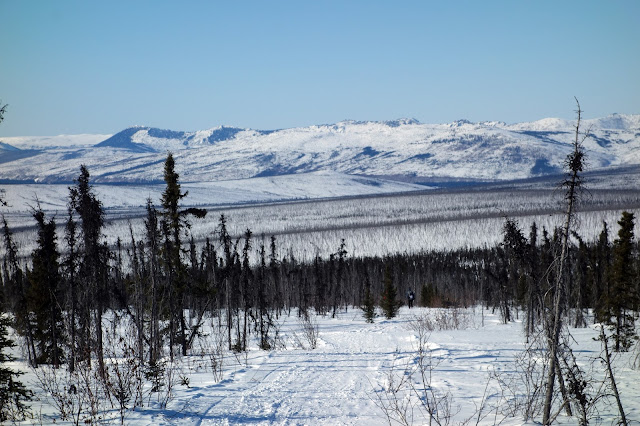
In "The Call of the Wild," Jack London more articulately described this sensation:
“He was mastered by the sheer surging of life, the tidal wave of being, the perfect joy of each separate muscle, joint, and sinew in that it was everything that was not death, that it was aglow and rampant, expressing itself in movement, flying exultantly under the stars.”
 |
| Friends! Danni and Wendy, with Bryon Powell and his phone in the background at the starting line of the WM100 |
The 2018 White Mountains 100 — this was the sixth time I'd lined up for this race, with finishes on a bike in 2010, 2011, 2012, 2014, and a foot finish in 2015. For all of this experience, this year was by far the least confident I'd ever felt, including 2010 when I was undertrained and really had no idea what I was getting into with this route — deep in Alaska's Interior, constant climbing and descending along narrow snowmobile trails that are dozens of miles from the nearest road access, likely to be deathly cold in late March, and often choked with hard ice and wet overflow. But I made it thanks to support from tireless volunteers and fellow nutty bikers and skiers. The White Mountains 100 has been my favorite race ever since.
This year, the 300-mile trek through soft snow to McGrath had left me with deeper fatigue than I'd anticipated. Prolonged muscle soreness in my upper legs led to suspicion about chronic exertional compartment syndrome of the quadriceps. But then I read more from Dr. Google and scolded myself. "You're not in pain like that. You're just being a baby because your leggies are tired." Over two weeks of "active recovery," I nearly regained the confidence I needed to start this race ... but then I took that ill-advised overnight trip to Eleazar's cabin last weekend.
 |
| Danni descending along the endless rollers to Moose Creek |
I may be a neurotic and uncertain person at heart, but I think even the most cocksure individual would find their courage pulverized if they'd experienced what I experienced one week prior to the race. My quad muscles went numb while dragging my sled through knee-deep snowdrifts out of Eleazar's cabin. Several times, I knelt into the snow because I was certain my legs could no longer support my weight. In 6.5 hours I traveled 12 miles, and was fully exhausted by the day's effort. That was Monday, and the White Mountains 100 started the following Sunday. Persistent soreness while barely moving for the rest of the week left no doubt about my odds of finishing the race.
"Even if trails somehow set up after that storm, it's still 100 miles on dead legs," I grumbled to friends.
Fear of pain, injury and failure gnawed at my rational side, but I was still more influenced by "Fear of Missing Out" and the reality that several friends and acquaintances were flying up from the Lower 48 to participate, along with many kindred souls who I've connected with in nine years of Fairbanks visits and White Mountains 100s. Could I really see myself willfully if prudently dropping out of "The Best Race Ever
®"?
No. No I could not.
 |
| Melanie Vriesman skiing past the trailside checkpoint above Moose Creek |
The race began much as my my five prior White Mountains 100s began, under the red glow of a rising sun after 45 minutes of standing around in single-digit temperatures blasted by a cold, cold wind. I used up all of the pre-race minutes chatting with folks and making five or six bathroom stops, so I spent some quality time in last place while I fumbled with layers, GPS and the backpack I was using. It was an untested 20-liter Ultimate Direction Fastpack that I borrowed from Bryon Powell, after having a "What was I thinking?" realization about my well-worn 12-liter pack from 2015. Of course, I was so anxious about my legs during pre-race week that I didn't even bother to pack it up and set out for a test hike. I've used untested items in 100-milers before. They usually work just fine, and the Fastpack was no exception.
After a few miles of readjustments, I did some jogging (real running! At least, not walking. The motion felt so strange) and caught up to Wendy and Danni.
"How are you feeling?" Danni asked me.
"My legs hurt," I complained. "I mean, it's not that bad, but ... this is mile three."
 |
| A cyclist with tubeless tire failure returns to checkpoint one on the wind-drifted trail |
The north wind continued to gain strength, blowing steadily at 15mph with gusts to 30mph. Much of the eastern side of this loop traverses wildfire-charred hillsides. The skeletons of spindly black spruce resemble a Dr. Seuss dystopia. Wind-drifted snow passes effortlessly through these burns, and it takes mere minutes to disappear the trail and all of the tracks from people who passed earlier. I felt like I was back on the Yentna River, rolling my feet over endless snow dunes as spindrift pummeled my face. With that experience still fresh in memory, my most pressing concern was my breathing. I'd struggled with asthma during the first third of the Iditarod Trail Invitational, and later decided this was most likely caused by breathing hard into the cold wind, which constricted my airways and resulted in mucous buildup that further obstructed my ability to breathe. My strategy to combat this problem during the White Mountains 100 was to reduce my effort level to something more sustainable than I'd pushed while battling my way up the Yentna River (admittedly not that difficult with sore legs and no sled to drag) and breathe into a thin buff stretched over my face. I dislike doing this because the buff becomes soaked and chills my face. But it's not so thick that it obstructs air flow, and the humid air results in happier lungs.
 |
| Descending toward Beaver Creek, with Cache Mountain in the background |
The first third of this race was challenging, for many of the same reasons as the first third of my ITI. After a week of back and forth indecision, I opted to leave my snowshoes behind. Without a flat platform to float atop soft snow, I had to take extra care to not roll my feet excessively and reignite the tendon swelling and pain that had only just abated. My pace felt glacial, but at least it wasn't sled-dragging hard. The roar of the wind became tedious so I turned on my iPod after seven hours. Although I was still moving in close proximity to my friends and several other women runners in the race, the headwind and exertion limited our conversations.
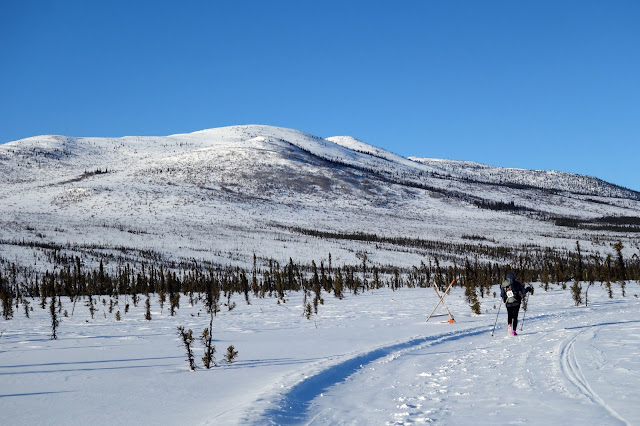 |
| Kathryn Bonuck of Portland, Oregon, on the drifted trail leading to Cache Mountain cabin |
Beautiful solitude, without the sting of loneliness — this is just one of the many reasons I love participating in races. It's assuring, knowing that others are out there feeling the emotions you are feeling, experiencing similar wonder, battling similar challenges and fears. The interesting psychology of this camaraderie makes it possible to go farther, sometimes much farther, than we otherwise could alone.
 |
| Wendy approaching Cache Mountain cabin at sunset |
Amid the intensity of the wind and focus on my footsteps and breathing, I'd managed to forget about leg pain for most of the first 40 miles. We neared the Cache Mountain checkpoint just as the sun slipped behind the western horizon. The cabin was crammed to the loft with skiers and runners, resting feet and legs as fatigue settled in for the long haul. A cheerful volunteer offered this checkpoint's highly anticipated baked potato with butter and cheese.
"Thanks, important stuff first," I replied as I removed my shoes and socks, hanging them over the wood stove to dry. I squeezed into a corner next to my friend Melanie and another Fairbanks skier I'd met at a bonfire earlier in the week, Christian. "Gotta dry your feet," I reasoned when they asked if I was leaving right away. Hurty feet were the one physiological issue I felt I could control, and I wasn't about to relinquish this.
Danni arrived just as I was heading out the door, about 45 minutes later. She was pale-faced and audibly wheezing, and told me her asthma was acting up. The sound of her speaking in a hoarse voice through shallow breaths was a visceral reminder of own struggle during the ITI. I recalled the frightening hours when I sleeplessly writhed in the unheated cabin at Shell Lake and pondered who I needed to call to secure a plane ride out of there. Feeling like you can't breathe is utterly awful; I never understood until I finally understood.
"It's the wind," I said. "Breathing into this wind is just ... ugh. But I think it might be dying down finally. Do you have an inhaler with you?"
I'd hoped to travel most of the course with Danni, and regret not hanging around longer to see whether she recovered. My own experiences warned me that she probably couldn't recover in time to meet the 40-hour cutoffs. I barely boosted myself out the door after seven hours at Shell Lake, and still continued to struggle with my breathing for the next day and a half. Danni waited through the night and took a snowmachine ride out in the morning, enjoying the scenic route along McKay Creek and lunch at the Chatanika Lodge. One thing about Danni, she knows how to do DNFs right.
 |
| Approaching Cache Mountain Divide at dusk |
Heading out the door, I felt lucky that the only thing holding me back were my legs, which were as stiff as rusty hinges after an hour of cool-down. I zombie-walked down the trail until my muscles warmed up, just in time to watch the last hints of twilight fade from the sky. Deepening purple hues revealed hints of green before the first stars arrived. As the trail veered west toward Cache Mountain Divide, I passed a man on foot and commented on the aurora's arrival. "Looks like it's going to be a good night," I said, and switched off my headlamp as soon as I passed. I wouldn't need the headlamp again until I left checkpoint three after 4 a.m., more than six hours later.
 |
| Aurora over Fossil Creek valley around 2 a.m. |
Hiking through the night by the light of a half moon beneath rippling aurora was an experience I'm sure I'll never succeed in reliving, no matter how many hallucinogenic drugs I try. Walking allowed the freedom to crane my neck upward for minutes at a time — comfortable in both my movements and my body temperature. Constant motion created an ever-changing canvas of mountains and sky that reignited awe at every turn. After the frozen-hand incident, I didn't attempt to stop again. Regaining the life in my hands was exhilarating, and although I couldn't recreate the miracle in my legs, this didn't prevent continued attempts at exalted hobble-jogging.
I was astonished how my brain could produce such depths of unbroken joy. I nearly always experience moments of euphoria during my longer endurance races, but this was literal hours in a sort of waking dream in which time stopped and I felt no pain. If I was a poet, I would write about the way the sky danced overhead as though solely for me, the beautiful, low-toned music that continued long after I resumed the moonlit march in silence, or how my whole body seemed to vibrate until I thought I might burst, such were my continued surges of energy after nearly 60 miles.
There were a few more occasions when I paused briefly to attempt to capture an image of the sky. As expected, the photos are disappointing. I look at them and think they don't begin to convey the truth, but then again, neither can my words.
 |
| Dawn in the depths of the cold |
I arrived at Windy Gap feeling full of life and boosted myself out of there fairly quickly, although I definitely had ultra brain — I knocked all three of my allotted meatballs and most of my soup onto the floor, and ate the meatballs anyway. (Aaaack! I won't even eat the "trail magic" food left in cabins because I'm convinced rodents have rifled through it. Eating meatballs that rolled through dirt and mouse turds atop a snowmachine boot and sweaty-feet-smeared floor?!? Argh!) And even though I'd consumed almost no water since leaving checkpoint two, I urged the volunteer to overfill my hydration bladder until it leaked onto the floor. When I stepped outside again, morning was approaching. The half moon had slipped behind the limestone crags towering over Fossil Creek, and tall spruce trees blotted out most views of the sky. I can't pretend I wasn't disappointed. If I could have waved some kind wand, I would have made that magic night last much longer.
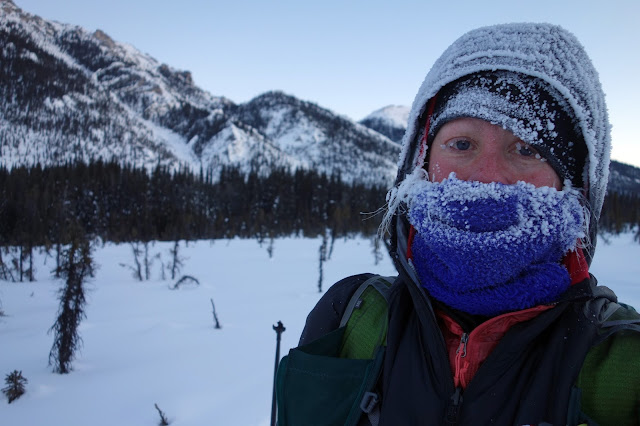
I left Windy Gap wearing my base layer, unzipped primaloft shorts, and soft-shell jacket. As dawn overtook the beautiful sky, a disconcerting creep of cold air settled around my body. I started by adding a mid-layer synthetic puffy jacket, then my fuzzy buff. I finally remembered to zip up my shorts and added fleece knee warmers over joints that now ached with cold. After another mile or so, a small panic set in and I made a longer stop to pull primaloft overboots over my cold toes (
so glad I brought those!), mittens, and a thin wind shell between my two jackets. The only items that remained in my pack were my "emergency" down coat, thin shell pants, liner beanie, three pairs of used and slightly damp fleece or Drymax socks, one pair of dry socks, and thin over-mitts. My arms, cut off from better circulation by the backpack straps, remained cold, but I was loathe to put on that down coat. There's something deeply unsettling about using up all of my layers, meaning I have no safety buffer beyond fire-starters and an emergency bivy. This was the only point during the race when I remotely missed my sled.
 |
| First light over Fossil Creek. |
Of course continued marching with a few more layers warmed me up just fine, until I was comfortable enough to stop for several minutes for, well, you know ... the morning constitutional. As I leaned against a spruce tree, I felt the depth of frost encrusted to my eyelashes and guessed it was 20 below zero along this low-lying valley. Volunteers in the adjacent and similarly low Beaver Creek valley measured minus 25 well after dawn.
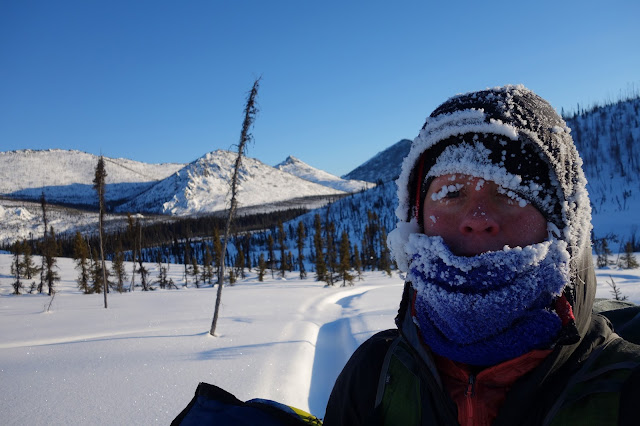 |
| Climbing out of Fossil Creek Valley well after sunrise. The cold stayed for a while. |
I was actually stoked that it was so cold. With my security blanket puffy jacket still safely stowed in my pack, I felt increasingly invincible to this sinister vapor swirling around me. And it was distracting enough that several more hours passed without giving a second thought to my legs, which, thanks to the exciting yet numbing cold, were moving more smoothly than ever.
 |
| A long climb on much improved trail |
The brightening skies and warmth of day two were not entirely welcome. As I climbed out of Fossil Creek Valley, nighttime bliss finally gave way to fatigue. For the first time in the race, I felt hints of nausea. This wasn't all that surprising, as I'd been subsisting almost solely on jelly fruit slices. Donald the Scottish biker turned me on to these miracle bursts of energy after donating his stash to me in Nikolai. After eight days of subsisting on healthy trail mix during the ITI, pure sugar was the rocket fuel that propelled me the final 20 miles into McGrath. Knowing I needed to do whatever I could to get through the White Mountains 100, I bought a pound of jelly fruit slices at Fred Meyer and burned through all of them by the end of the race. I have no regrets. No regrets! But I did hope the stomach ache was from all of this candy, and not an early symptom of hantavirus from the floor meatballs.
 |
| Surprised to see a biker pass me near mile 75. |
I was still in a good mood as I checked into Borealis cabin, slurped up a bowl of instant ramen noodles, slathered lube on my feet, changed my socks, and got out of there in less than 20 minutes. Before arriving, I'd already removed most of my clothing layers even as ice remained encrusted on my eyelashes and hat. I commented about the heat to a volunteer, and he glanced at the outdoor thermometer to inform me that it was still 1 below zero, at 11 a.m.
"So it's going to be a cooker today," I said like a smug Alaskan that I am totally not, and replaced my thick windproof hat with the still-damp liner hat, then removed my primaloft shorts, fleece socks and gaiters to help cool my legs. They were throbbing, and stiffened up immediately. Even with the swift retreat from Borealis, I could scarcely contain tears as I battled the rusty hinges to resume walking.
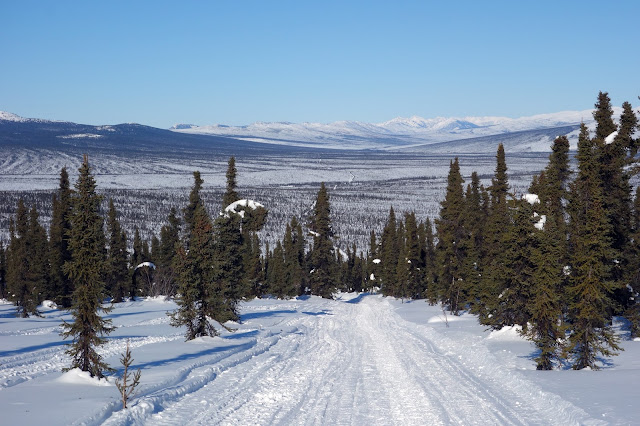 |
| View from the Wickersham Wall |
My mood deteriorated from there. Although slightly soft, there trail was no longer covered in wind-drifted snow, so there wasn't uneven footing to distract me. The wind had died, so I no longer had to concentrate on steady movement and breathing. The warming air and second-day heat pouring from my body meant there was no longer cold to distract me. The aurora was gone, the sun was oppressively bright, and the terrain was all too familiar and uninspiring. I was hiking along the Wickersham Creek valley, with its shallow rollers that somehow feel endlessly uphill without gaining altitude, while spending nine miles staring at the Wickersham Wall, which never seems to get any closer, even if you walk for three hours. All I had left was my pain — my throbbing, hot, relentless pain. And despite my pep talk with Wendy before the start, there was no making friends with my pain.
 |
| Photo by Danni Coffman, one mile before the finish |
I'd love to say I worked through my pain and spent the final miles in satisfied reflection, but I learned that — just as it's possible to spend 20 miles enveloped in total joy — it's also possible to spend 20 miles focused solely on pain. I did what I could to distract myself. I moaned often, loudly, without shame. I briefly attempted hobble-jogs that had become almost comical with awkward stumbling. I dropped onto my knees at one point to try crawling down a hill, also without shame. I continued having strange hallucinations of my friend Wendy, wearing her big white parka and waiting for me on the side of the trail ... and discovered, every time, that this was just another snow-covered tree. I turned up my iPod and sang along loudly, completely without shame ... mostly to Judah and the Lion, which I had adopted as my official 2018 White Mountains 100 soundtrack.
"
We'll be growing old and gray.
We'll be getting through the good times, same pain.
We'll be making the years go by like days,
Cause you're my forever, you're my forever, you're my always."
Through all this, I remembered my love for the White Mountains, for the familiarity and the surprise, the harshness and benevolence, the life-changing realizations, the highs and the lows. I gritted my teeth and glanced to the south, toward a ripple of rounded domes, the trans-Alaska Pipeline, hazy views of the Hayes Range — still beautiful, even through a lens of pain.
Danni hiked out to meet me a mile from the finish, and I was overjoyed to see her. About 50 yards before the finish, I saw Beat standing next to the trail in his big coat with a full beard and wind-burned face. It was the first time I'd seen him in a month.
"You're here," I wheezed, and reached out to embrace him before he could walk away and make me finish this race. "Congrats, you did awesome," I said, regarding his fourth finish in Nome, a place he'd reached just 48 hours earlier. He'd managed to grab a couple nights of rest, fly from Nome to Anchorage to Fairbanks, and drive my rental car to the Wickersham Dome trailhead while I plodded along the course.
Race director Joel handed me a belt buckle and let me officially finish before 6 p.m., for a time of 33:59. It's pretty far from the under-30-hour finish I managed in 2015, and blows away my pre-ITI hubris about walking the ITI350 to build bulletproof fitness for a fast time at the Whites. But damn, I actually made it through with only 20 percent grumbling, 40 percent striving, and 40 percent effortless and exhilarating awe. I couldn't ask for better odds if I dreamed the entire experience, which I'm still not 100 percent sure I hadn't.










































































